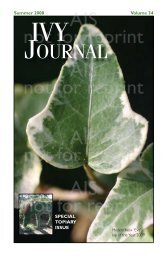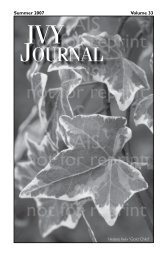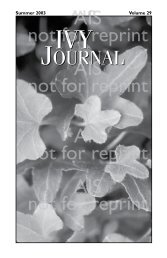You also want an ePaper? Increase the reach of your titles
YUMPU automatically turns print PDFs into web optimized ePapers that Google loves.
AIS<br />
not for reprint<br />
German or Parlor <strong>Ivy</strong> - Senecio mikanioides<br />
Senecio mikanioides is a daisy relative from South Africa,<br />
which is evergreen in mild climates and deciduous in<br />
colder climates. It will grow in sun or shade and is considered<br />
a weed in Coastal California. Believe it or not, German<br />
<strong>Ivy</strong> is sometimes mistaken for Hedera because its leaves are<br />
similar in shape, but their color is brighter green. The<br />
coarsely toothed leaves grow on a viny stem, which trails<br />
or climbs. Mature plants form clusters of small, bright yellow daisy-like flowers.<br />
They grow very fast and must be tip-pruned regularly for a compact houseplant.<br />
AIS<br />
not for reprint<br />
German <strong>Ivy</strong> can be distinguished from Hedera by the fleshy and easily broken<br />
stems and leaves.<br />
Swedish <strong>Ivy</strong> - Plectranthus oertendahlii<br />
Swedish <strong>Ivy</strong> has shiny, dark green, thick leaves with scalloped<br />
edges and pronounced veins. The flowers are white to<br />
blue and are arranged on spikes. Best known as a houseplant<br />
or a hanging basket plant and very easy to grow, it<br />
tolerates partial shade and full shade. In coastal Southern<br />
California it is used as a ground cover and is especially<br />
suited to hanging over a wall, raised bed edge, or a container<br />
in shady areas.<br />
AIS<br />
not for reprint<br />
Although it does not have the true ivy leaf shape, Swedish <strong>Ivy</strong> is similar to<br />
Hedera because it is shade tolerant, easy to grow, trailing, and roots in water.<br />
However, the delicate spikes of bluish flowers are an instant give away that it is<br />
not a Hedera.<br />
Kenilworth <strong>Ivy</strong> - Cymbalaria muralis<br />
This dainty plant is a creeper with kidney-shaped;<br />
irregularly lobed 1” wide leaves with shallowly scalloped<br />
edges. The miniature lilac-blue snapdragon-type flowers<br />
have yellow throats. It’s a native of the Alps and grows<br />
wild in the Appalachian Mountains. New plants are easily<br />
AIS<br />
not for reprint<br />
grown because it is a creeper and roots wherever it<br />
touches moist ground. As a matter of fact, Kenilworth <strong>Ivy</strong> is considered a weed<br />
in warmer climates and also in greenhouses across the country because it<br />
seems to just show up all on its own. It is a perennial in warm climates like<br />
southern California, but grown as an annual in colder parts of the country and<br />
sold as a houseplant.<br />
The prolific flowers, not found on any Hedera, easily identify this beautiful little<br />
weed.<br />
7





